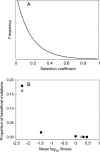Understanding the evolutionary fate of finite populations: the dynamics of mutational effects
- PMID: 17407380
- PMCID: PMC1845161
- DOI: 10.1371/journal.pbio.0050094
Understanding the evolutionary fate of finite populations: the dynamics of mutational effects
Abstract
The most consistent result in more than two decades of experimental evolution is that the fitness of populations adapting to a constant environment does not increase indefinitely, but reaches a plateau. Using experimental evolution with bacteriophage, we show here that the converse is also true. In populations small enough such that drift overwhelms selection and causes fitness to decrease, fitness declines down to a plateau. We demonstrate theoretically that both of these phenomena must be due either to changes in the ratio of beneficial to deleterious mutations, the size of mutational effects, or both. We use mutation accumulation experiments and molecular data from experimental evolution to show that the most significant change in mutational effects is a drastic increase in the rate of beneficial mutation as fitness decreases. In contrast, the size of mutational effects changes little even as organismal fitness changes over several orders of magnitude. These findings have significant implications for the dynamics of adaptation.
Conflict of interest statement
Figures




References
-
- Crow JF, Kimura M. An introduction to population genetic theory. New York: Harper and Row; 1970. 656
-
- Bateman AJ. The viability of near-normal irradiated chromosomes. Int J Radiat Biol. 1959;1:170–180.
-
- Chao L. Fitness of RNA virus decreased by Muller's ratchet. Nature. 1990;348:454–455. - PubMed
Publication types
MeSH terms
Associated data
- Actions
- Actions
- Actions
- Actions
- Actions
- Actions
- Actions
- Actions
- Actions
- Actions
- Actions
- Actions
- Actions
- Actions
- Actions
- Actions
- Actions
- Actions
- Actions
- Actions
- Actions
- Actions
- Actions
- Actions
LinkOut - more resources
Full Text Sources
Other Literature Sources

